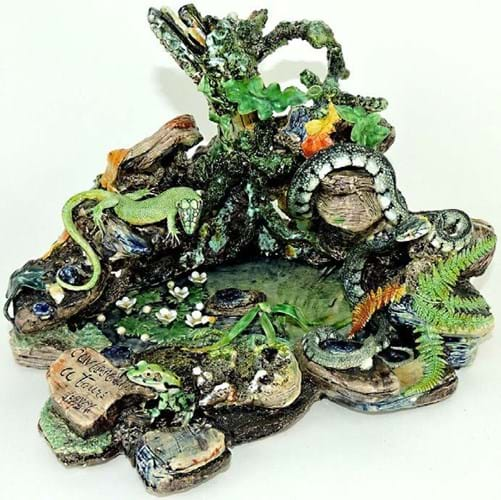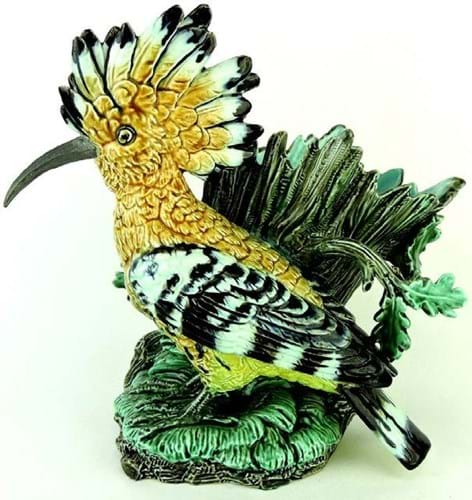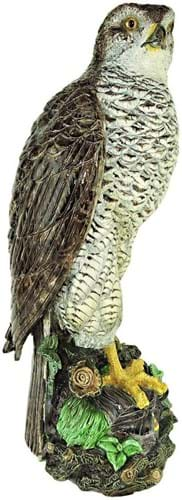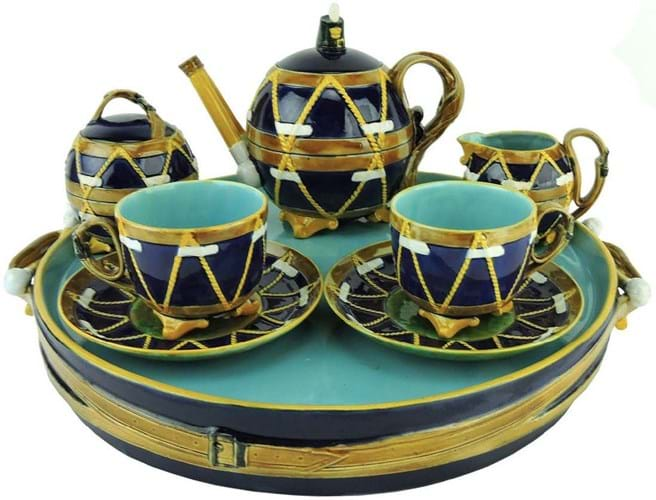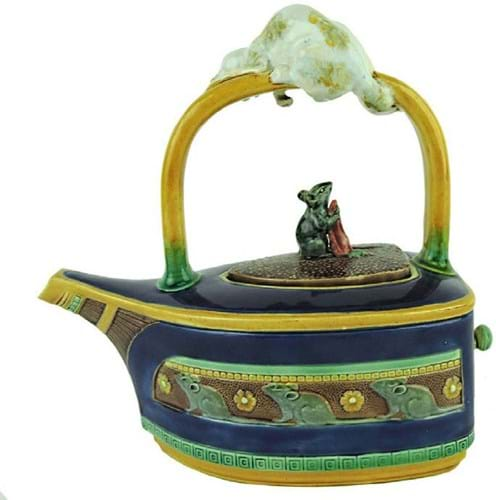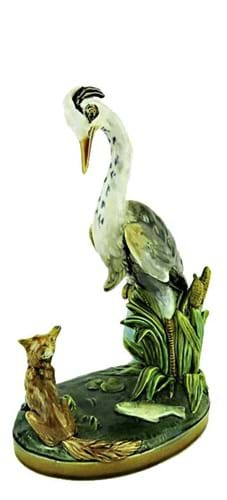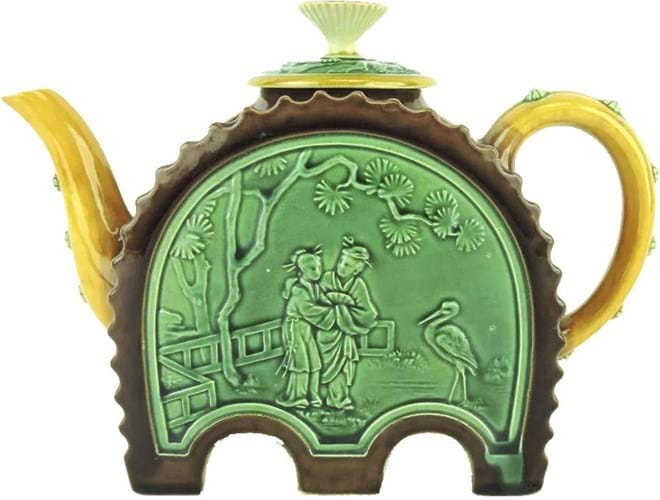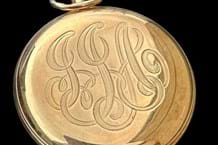A dealer since the age of 19, London-based Nick Boston has helped build some of the greatest majolica collections. But few collections of 19th century tin-glazed earthenwares are as large or as varied in scope as that assembled by the property lawyer Edward Flower (1929-2022) and his wife Marilyn (1930-2017).
“Their ‘way’ was a very scholarly way but also a very passionate way, which in my experience is how the greatest collections are built”, Boston recalls. “Rarity, whimsy, history and aesthetics, the Flower collection has it all.”
The Flowers were inveterate collectors: first it was American Impressionism, then artist-signed prints and British art pottery (61 lots sold by Doyle New York in December) and latterly majolica.
Across three sales more than 600 pieces, mostly acquired since the bug bit hard 30 years ago, are being offered by specialist Strawser Auction Group (23% buyer’s premium).
The first tranche of 190 lots was held in Kulpsville, Pennsylvania, on August 23.
Cover star
It is an indication of collecting fashion and the Flowers’ love of all members of the majolica family that a 22in (55cm) Palissy-style ‘art of the earth’ basin shared the top price of the sale.
Pictured on the front page of ATG No 2608, this large, signed and dated example of an increasingly popular type, sold well above its $2000-3000 to an internet bidder for $40,000 (£32,000).
Teeming with life, from a pike laying in a pool of water to the centre to a lush border populated by lizards, a snake and a frog, it was inscribed and dated Avisseau, Tours, 1856 for Charles-Jean Avisseau (1795-1861).
The French ceramicist, based in Saint-Pierre-des-Corps, is often credited with rediscovering the techniques of Bernard Palissy (c.1510-90) although his most ambitious creations often went well beyond those of the Renaissance potter.
Also signed and dated 1856 was an Avisseau ‘grotto’ group modelled as a naturalistic forest floor scene with a snake, lizard and frog climbing on rocks and vegetation. Measuring 6 x 10in (15 x 25.5cm), it took $18,000 (£14,400) against an estimate of $3000-5000. It had been sold by the auction house in October 2017 for $14,000.
Continental European wares, once the slightly poorer relation to pieces by the best Staffordshire factories, were a strength of the sale. Particularly well received was a menagerie of large naturalistic models by the Massier Brothers, Choisy Le Roi and Hugo Lonitz factories. All had been displayed together in the Flowers’ Bay Shore, New York, residence.
A 2ft (60cm) high model of a hawk perched on a rocky ground with ferns and branches made by Lonitz, c.1875, was guided at $20,000-25,000 and took $40,000 (£32,000). In fine condition, apart from a small loss to the tail feather, it is the same model sold for $30,000 in October 2017. The only other one known sold at Christie’s New York in November 2011, realised $56,250.
Also among only two known examples, a Lonitz jardiniere modelled as a hoopoe perched on an open tree trunk sold at $10,000 (£8000).

Pheasants floor vase by Choisy le Roi signed for Louise Robert Carrier Belleuse, $6500 (£5200) at Strawser.
A floor vase by Hippolyte Hautin Boulanger & Cie of Choisy le Roi, France, is one of only three known. The 2ft 1in (63cm) model of brightly glazed male and female golden pheasants strutting around a broken vase is signed for Louise Robert Carrier Belleuse, the son of the better-known sculptor Albert Carrier Belleuse and Hautin Boulanger’s premier modeller. It took $6500 (£5200).
Exhibition spotlight
Several pieces in the Flower collection were recently featured in the exhibition Majolica Mania: Transatlantic Pottery in England and the United States, 1850-1915, that was launched at the Bard Graduate Center, New York City in autumn of 2021, then travelled to the Walters Museum in Baltimore in early 2022 before ending in the UK at the Potteries Museum & Art Gallery, Stoke-on-Trent, in January this year.
Among the pieces chosen for Majolica Mania was an extraordinary piece by Brown Westhead Moore & Co. This 2ft 1in (63cm) high vase modelled with clouds and a coiling dragon was designed by Mark V Marshall (better known for his work at the Doulton Lambeth factory) for display at the Philadelphia Centennial Exhibition of 1876. An example is illustrated in the second volume of The Masterpieces of the Centennial International Exhibition Illustrated published in 1876-78. With a professional repair to the top rim, it took $10,000 (£8000).
Also from Majolica Mania was a George Jones cabaret set or tete-a-tete c.1875 with each of the elements designed as cobalt blue drums, with yellow stringing. Drumsticks form the spout of the teapot with a drummer boy’s hat the finial. One of only two known complete sets with all the elements in good condition, it took $37,500 (£30,000).
Among the most popular lots from the George Jones factory was a pair of tulip and butterfly pattern candlesticks - rare elements from a dressing table for which the original Jones artwork still survives. As each of the pieces could be purchased separately, some of the larger elements or the optional extras were sold in only small numbers.
The candlesticks, seemingly the only pair known, sold at $21,000 (£16,800) followed by bids of $6000 (£4800) each for a matching single chamberstick and an oval dressing table tray.
Rarely outbid
After retirement in the early 2000s, Edward and Marilyn Flower attended almost every majolica auction held by Strawser Auction Group.
Rarely outbid when they spotted a piece they had to have, they were particularly strong buyers when the collection of Marilyn Karmason, co-author with Joan Stacke Graham of Majolica: A Complete History & Illustrated Survey (1989), was sold by Strawser in 2005.
Some of the best-known Minton and George Jones models have fallen from the sums commanded at that sale.
Sold at $37,500 (£30,000) was a well-preserved version of the celebrated cobalt blue Flat Iron teapot modelled with a frieze of mice to the sides and a white cat wrapped around the handle. The design has an uncertain attribution to Christopher Dresser. The example in the Karmason collection hammered at $65,000 in 2005.
Among the most recent additions to the collection was a George Jones Sea and Sky stilton cover and stand purchased at Doyle’s in New York in December 2021 as part of the collection of Joan Stacke Graham. Modelled with aquatic life in a cobalt sea and avian life in a turquoise sky, it had brought $15,000 in New York and this time made $13,000 (£10,400).
Rarities revealed
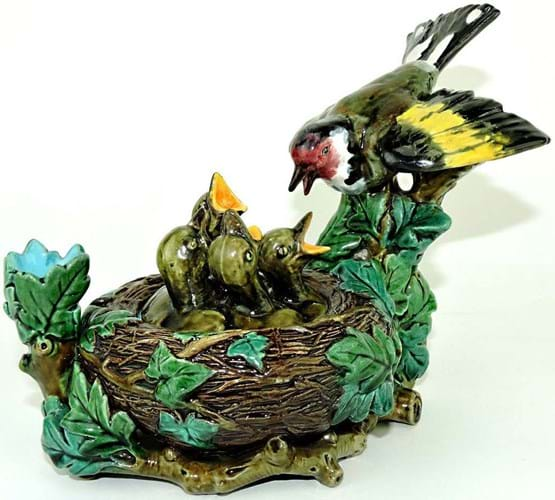
Minton trinket box modelled as a goldfinch tending three hungry chicks in a nest, $11,000 (£8800) at Strawser.
The Flowers sale was a rare opportunity to see a number of rarities known only from the collecting literature.
Sold at $11,000 (£8800) was a Minton trinket box modelled as a goldfinch tending three hungry chicks in a nest. It is one of only a handful known. Rarer still is the only known majolica-glazed example of the Minton group depicting the fable of the Fox and the Heron. One for the connoisseur, it rang up $4750 (£3800).
Also the only recorded example of its type and sold at $13,000 (£10,400) was a horseshoe-form teapot modelled with scenes of a Japanese garden in the Aesthetic movement taste. The designer is thought to be John Henk, whose best-known designs for Minton are a pair of vases naturalistically modelled as a hen and a rooster.


